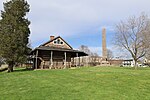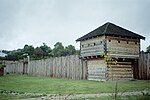Silver Bridge

The Silver Bridge was an eyebar-chain suspension bridge built in 1928 which carried U.S. Route 35 over the Ohio River, connecting Point Pleasant, West Virginia, and Gallipolis, Ohio. Officially named the Point Pleasant Bridge, it was popularly known as the Silver Bridge for the color of its aluminum paint. On December 15, 1967, the Silver Bridge collapsed amid heavy rush-hour traffic, resulting in the deaths of 46 people, two of whom were never found. Investigation of the wreckage soon pointed to the failure of a single eyebar in one of the suspension chains as the primary cause — a finding noted in a preliminary report released within 10 months of the collapse. However, to explain why that eyebar failed — a failure triggered by a flaw just 0.1 inches (2.5 mm) deep, which led to a fracture — required significantly more time and effort to uncover, with the final accident report taking three years to complete. The collapse led to significant changes in the way bridges in the U.S. are inspected and maintained. The collapsed bridge was replaced by the Silver Memorial Bridge, which was completed in 1969.
Excerpt from the Wikipedia article Silver Bridge (License: CC BY-SA 3.0, Authors, Images).Silver Bridge
Point Pleasant Biking & Walking Trail,
Geographical coordinates (GPS) Address Nearby Places Show on map
Geographical coordinates (GPS)
| Latitude | Longitude |
|---|---|
| N 38.845 ° | E -82.141111111111 ° |
Address
Point Pleasant Biking & Walking Trail
Point Pleasant Biking & Walking Trail
25106
West Virginia, United States
Open on Google Maps







